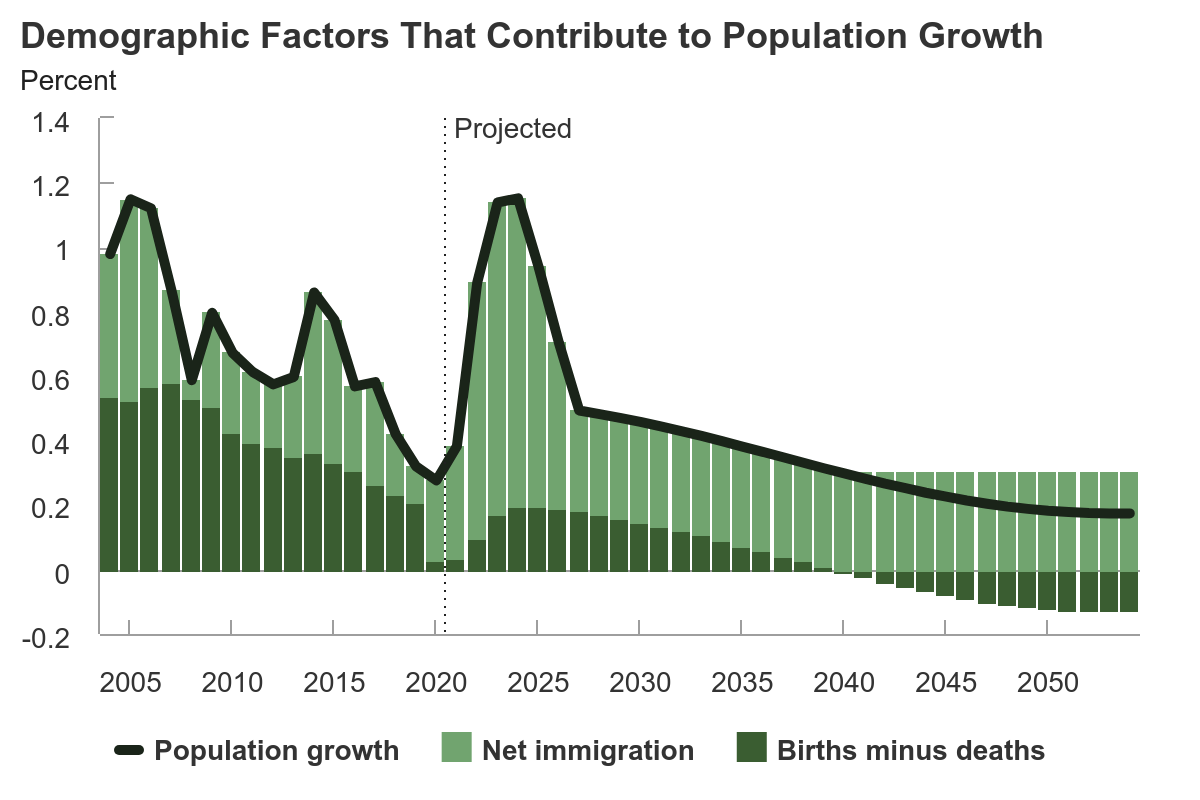At a Glance
The size of the U.S. population, as well as its age and sex composition, has significant implications for the economy and the federal budget. For example, the number of people ages 25 to 54 affects the number of people employed, and the number of people age 65 or older affects the number of Social Security and Medicare beneficiaries.
In this report, the Congressional Budget Office describes its population projections, which underlie the agency’s baseline budget projections and economic forecast that will be published in early 2024.
- Population. In CBO’s projections, the Social Security area population—the relevant population for estimating Social Security payroll taxes and benefits and the measure of population used in this report—increases from 342 million people in 2024 to 383 million people in 2054. As growth of the population age 65 or older outpaces growth of younger age groups, the population continues to become older, on average.
- Population Growth. Population growth generally slows over the next 30 years, from 0.6 percent per year, on average, between 2024 and 2034 to 0.2 percent per year, on average, between 2045 and 2054. Net immigration increasingly drives population growth and accounts for all population growth beginning in 2040, in part because fertility rates remain below the rate that would be required for a generation to replace itself in the absence of immigration.
- Civilian Noninstitutionalized Population. The civilian noninstitutionalized population—which consists of people age 16 or older who are not members of the armed forces on active duty and who are not in penal or mental institutions or in homes for the elderly or infirm—grows from 271 million people in 2024 to 310 million people in 2054, expanding by 0.4 percent per year, on average. The number of people ages 25 to 54 (who are more likely to work than people in other age groups) grows at an average annual rate of 0.3 percent over that period—more slowly than in recent decades.
- Changes Since Last Year. The Social Security area population is projected to be larger (by 2.4 percent in 2053) and to grow slightly faster, on average, than CBO projected last year. Upward revisions to net immigration from 2024 to 2026, which boost the size and growth of the population ages 25 to 54 in particular, account for most of that difference. Partially offsetting that change is a reduction in the projected total fertility rate, from 1.75 to 1.70 births per woman. CBO also reduced its projection of mortality rates for people age 65 or older over the first two decades of the projection period, reflecting fewer deaths due to COVID-19 than the agency previously projected.
CBO’s projections of the rates of fertility, mortality, and net immigration are highly uncertain. Small differences between CBO’s projections of those rates and actual outcomes could compound over many years and significantly alter demographic outcomes by the end of the projection period.
Notes
Unless this report indicates otherwise, all years referred to are calendar years.
Numbers in the text and figures may not add up to totals because of rounding.
The population projections in this report reflect developments through November 21, 2023.
The underlying data for the figures in this report, as well as supplemental population projections, are posted with the report on CBO’s website at www.cbo.gov/publication/59697#data.
Definitions of terms used in this report are provided in Appendix C.
Projected changes in the size of the U.S. population, as well as its age and sex composition, significantly affect the outlook for the economy and the federal budget. For example, the number of people who are employed and paying taxes on their wages depends on the size of the population ages 25 to 54, and the number of beneficiaries of some federal programs (including Social Security and Medicare) depends on the size of the population age 65 or older.
To project the population in future years, the Congressional Budget Office starts with the most recent available historical data and then projects rates of fertility, mortality, and net immigration. In this report, CBO defines the population as that used for estimating Social Security payroll taxes and benefits, known as the Social Security area population (see Appendix C for the definition of that population).
In CBO’s projections, the population increases from 342 million people in 2024 to 383 million people in 2054, growing by 0.4 percent per year, on average, or by less than one-half the pace experienced from 1974 to 2023 (0.9 percent per year). Over the next decade, immigration accounts for about 70 percent of the overall increase in the size of the population, and the greater number of births than deaths accounts for the remaining 30 percent. After 2034, net immigration increasingly drives population growth, accounting for all population growth beginning in 2040. (For a comparison of CBO’s population projections with those of other agencies, see Appendix A.)
CBO’s projections of the population over the 2024–2054 period are highly uncertain, especially in later years. If rates of fertility, mortality, or net immigration were higher or lower than in the agency’s projections, then the resulting population would differ from the amounts shown here. The effects would be larger in later years of the projection period than in the earlier years because differences in those rates compound in each year of the period.
Demographic Factors That Contribute to Population Growth
Percent

By 2040, with the aging of the population, deaths exceed births in CBO’s projections. As a result, net immigration accounts for all population growth after that point; without immigration, the population would shrink.
The Size and Age Composition of the Population
The population is projected to become older, on average, over the 2024–2054 period. In CBO’s projections, the number of people age 65 or older rises, and growth of that group outpaces growth of younger age groups.
Population, by Age Group
Millions of people
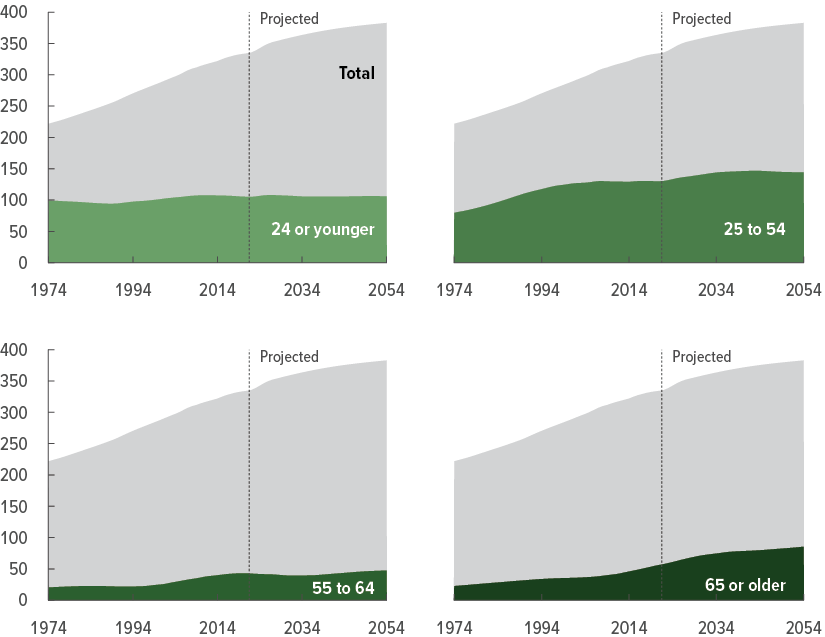
In CBO’s projections, the number of people ages 25 to 54, which particularly affects the number of people employed, grows more slowly than the number of people age 65 or older, who are less likely to work and who are generally eligible for Social Security and Medicare.
Population Ages 25 to 64 Relative to the Population Age 65 or Older
Ratio

In 2024, the ratio of people ages 25 to 64 to people age 65 or older will be 2.9 to 1, CBO projects. By 2054, it will be 2.2 to 1.
Components of Population Growth
Population growth is determined by births, deaths, and net immigration. In CBO’s projections, fertility rates remain lower than the replacement rate (that is, the fertility rate required for a generation to exactly replace itself in the absence of immigration, or 2.1 births per woman), mortality rates generally continue to decline, and immigration becomes an increasingly important part of overall population growth.
Fertility
CBO projects fertility rates on the basis of its assessment of historical trends and other factors. For the 20 years before the 2007–2009 recession, the total fertility rate was 2.02 children per woman, on average. After peaking at 2.12 in 2007, the rate has generally fallen, largely because of lower fertility rates among women ages 15 to 24.1 The rate equaled 1.64 births per woman in 2020 and rose to 1.67 in 2022 (the most recent year for which data were available when the projections were made).
In CBO’s projections, the total fertility rate remains at 1.67 births per woman through 2024 and then rises as fertility rates increase among women ages 30 to 49. In CBO’s assessment, that increase in fertility rates occurs, at least in part, because some of the decline in fertility at younger ages stems from delayed childbearing. By 2034, the total fertility rate is projected to be 1.70 births per woman, where it remains through 2054.
CBO’s projections of fertility rates are subject to significant uncertainty. If trends in fertility, such as the delay in childbearing and the rising average age of mothers, differed from CBO’s projections, then the agency’s projections of overall fertility rates and the age distribution of mothers would change.
Fertility Rates
Births per woman
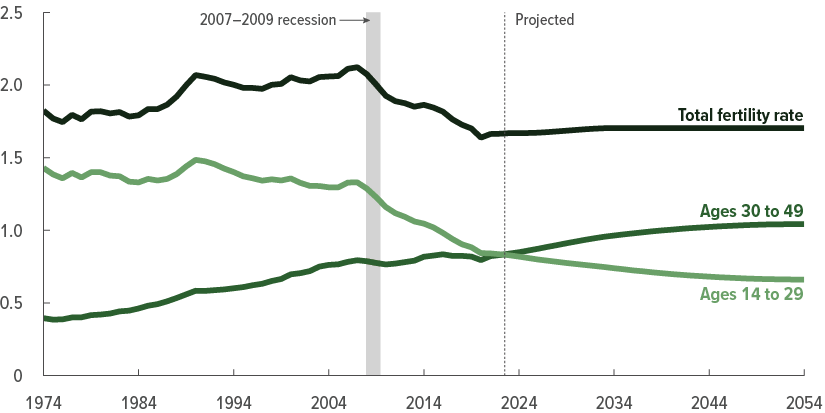
In CBO’s projections, fertility rates rise for women of older childbearing ages and fall for women of younger childbearing ages. That pattern is consistent with the recent trends of delayed childbearing and the rising average age of mothers.
Mortality
CBO projects mortality rates on the basis of historical trends. The agency then takes into account the effects of COVID-19.
Since at least the early 20th century, mortality rates in the United States have generally decreased (meaning that life expectancy has generally risen), and they have decreased more quickly for younger people than for older people. Since about 2010, though, the overall rate of decline has slowed, and mortality rates have increased for some groups, particularly younger people.
To account for those trends, CBO estimates that mortality rates (calculated for five-year age groups and measured before including the effects of COVID-19) will change from 2021 to 2025 at roughly the same average rate that they did for each age group from 2010 to 2019. After 2025, mortality rates are projected to return to longer-term trends and decline at a faster average rate than they did between 2010 and 2019. In CBO’s projections, after 2025, mortality rates decline at the average rate that they declined over the entire 1950–2019 period. That average incorporates both the period of faster decline before 2010 and the period of slower decline and reversal that some groups experienced between 2010 and 2019. The net effect is a continued decline in mortality rates.
After projecting mortality rates on the basis of historical trends, CBO incorporated the effects of COVID-19 on mortality rates through 2025 by increasing those rates, especially for older people (who are more likely to die from that illness). Although COVID-19 was a leading cause of death in recent years, in CBO’s projections the long-term trend of declining mortality rates continues and more than offsets the projected effects of COVID-19 in the surviving and future populations. Consequently, life expectancy at birth and at age 65 increases.
Mortality rates in the long term are uncertain because factors such as the evolution of medical technology and environmental conditions may have different effects in the future than they have had in the past. It is also uncertain how long the recent slowdown in the decline of the mortality rate will continue.
Mortality Rate, Adjusted for Age and Sex
Deaths per 100,000 people

In CBO’s projections, mortality rates decline from 2024 to 2054. As a result, over those years, life expectancy at birth is projected to increase from 78.7 years to 82.2 years, and life expectancy at age 65 is projected to increase from 19.6 years to 21.8 years.
Net Immigration
For the first two decades of the projection period (2024 to 2044), CBO’s estimates of net immigration (the number of people who enter the United States in a given year minus the number who leave in that year) are based on the agency’s assessment of recent trends in immigration. After 2044, net immigration in a given year is projected to grow at roughly the same rate as projected population growth in the previous year—0.2 percent per year, on average.
CBO develops its projections so that they fall in the middle of the likely range of outcomes without new legislation. Several factors contribute to the uncertainty of CBO’s projections of net immigration. Changing conditions in immigrants’ countries of origin, for example, could significantly affect outcomes. In addition, estimates and projections of net immigration of people who enter the United States illegally are particularly uncertain because information about that group is hard to obtain and difficult to assess when available.
Net Immigration
Millions of people
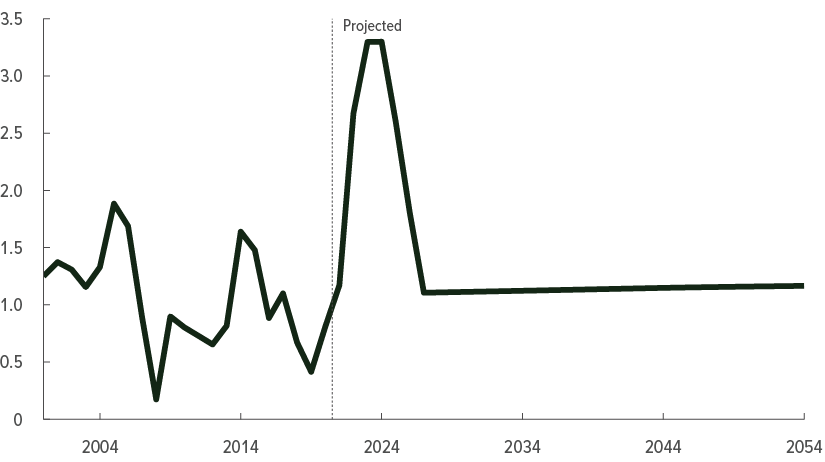
CBO estimates that net immigration to the United States was 2.6 million in 2022 and 3.3 million in 2023. Those estimates are larger than net immigration from 2010 to 2019, which averaged 900,000 people per year.
The agency projects that, on net, the number of people immigrating to the United States will be 3.3 million in 2024, 2.6 million in 2025, 1.8 million in 2026, and will average 1.1 million per year over the 2027–2054 period.
Net Immigration, by Category
To develop its projections of net immigration, CBO groups people into three categories (see Appendix C):
- The LPR+ category includes lawful permanent residents (LPRs) plus people who are eligible to apply to become LPRs on the basis of their current status, such as asylees and refugees.
- The INA nonimmigrant category refers to people admitted as nonimmigrants under the Immigration and Nationality Act (INA), including students and temporary workers.
- The other-foreign-national category consists of people in the United States who are not in the first two categories and who have not subsequently become U.S. citizens or received LPR, asylee, or nonimmigrant status—such as people who entered the United States illegally and people who were permitted to enter through the use of parole authority and who may be awaiting proceedings in immigration court.
In CBO’s projections, total net immigration from 2024 to 2026 is larger than it was in the past, primarily reflecting the agency’s assessment that net immigration of people in the other-foreign-national category in 2024 will be similar to what CBO estimates it was in 2023 (see Appendix B) and then will decline in 2025 and 2026 as the immigration system adjusts (without new legislation) to the increase in immigration. After 2026, net immigration of other foreign nationals returns to a number that is closer to historical levels. The decline in net immigration between 2024 and 2026 may stem from changes in decisions by other foreign nationals to enter or leave the United States, changes in actions by the Administration or immigration judges, or a combination of those changes.
Net Immigration, by Category
Millions of people
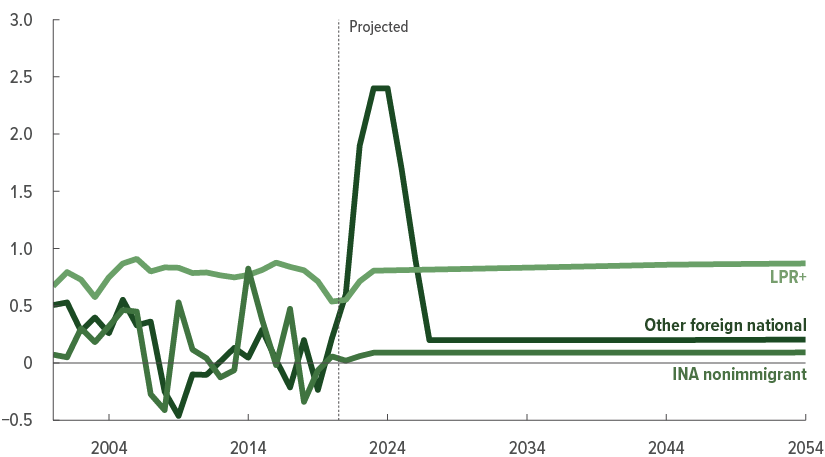
Net immigration of people in the LPR+ category increases from 820,000 per year, on average, over the 2024–2034 period to 870,000 per year over the 2045–2054 period. Over the entire period, net immigration of people in the INA nonimmigrant category averages 90,000 per year. Net immigration in the other-foreign-national category averages 1.7 million people per year from 2024 through 2026 and 200,000 thereafter.
Population Used to Project the Labor Force
To estimate the size of the labor force, CBO uses the civilian noninstitutionalized population. To project that population, CBO uses the historical ratio of the Social Security area population to the civilian noninstitutionalized population, by sex and age group.
In CBO’s projections, the civilian noninstitutionalized population rises from 271 million in 2024 to 310 million in 2054, or at an average rate of 0.4 percent per year. The number of people age 65 or older grows at an average annual rate of 1.1 percent, which is faster than the growth rate for people ages 25 to 54 (0.3 percent per year). The number of people ages 16 to 24 declines slightly, on average, over the projection period.
Uncertainty in CBO’s projections of the civilian noninstitutionalized population stems from uncertainty in the underlying components. If the rates of fertility, mortality, and net immigration diverged from those in CBO’s projections, then measures of the population used to project the labor force would differ as well.
Civilian Noninstitutionalized Population, by Age Group
Millions of people
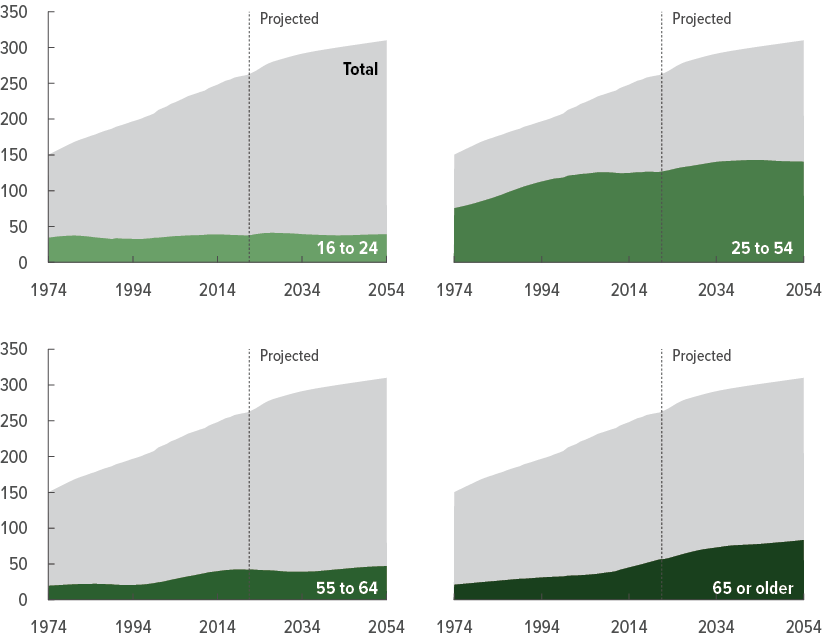
People ages 25 to 54 are most likely to participate in the labor force. Growth in the number of people in that age group over the next 30 years is projected to be slower than it was from 1974 to 2023. CBO projects that over the next 30 years, 74 million people, on average, will be age 65 or older and thus generally eligible for Social Security and Medicare and unlikely to work. That number is about twice the average number of people in that group from 1974 to 2023.
Changes to CBO’s Population Projections Since Last Year
All told, changes to projected rates of fertility, mortality, and, particularly, net immigration mean that CBO now expects the population to be larger and to grow faster, on average, than the agency projected last year. In this year’s projections, the population in 2053 (the final year covered in last year’s report) is projected to have 8.9 million more people, an increase of 2.4 percent.
Upward revisions to the size of the population ages 25 to 54—stemming from greater projected net immigration—account for 57 percent of the overall increase in the annual population estimates from 2024 to 2053. Changes to the number of people age 24 or younger, ages 55 to 64, and age 65 or older account for 25 percent, 9 percent, and 9 percent, respectively, of the overall increase. Those changes are the result of greater projected net immigration, lower projected rates of fertility, and lower projected rates of mortality from COVID-19 than in last year’s projections.
Population in CBO’s 2023 and 2024 Projections, by Age Group
Millions of people
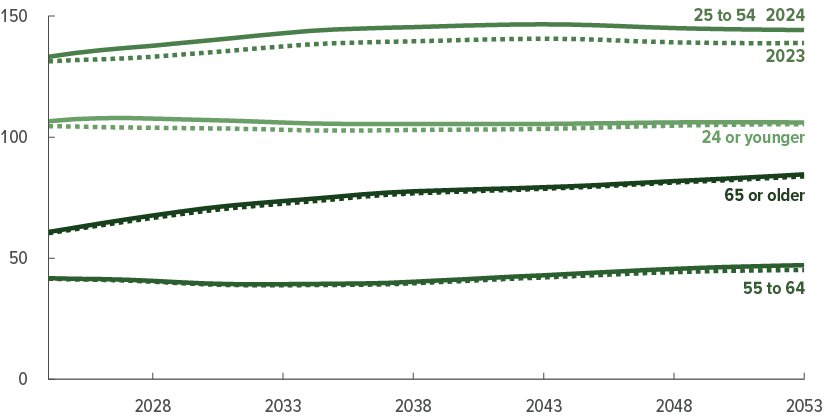
In CBO’s projections, increased net immigration means that there will be more people age 24 or younger and ages 25 to 54 in each year from 2024 to 2053 than CBO projected last year.
Population Ages 25 to 64 Relative to the Population Age 65 or Older in CBO’s 2023 and 2024 Projections
Ratio
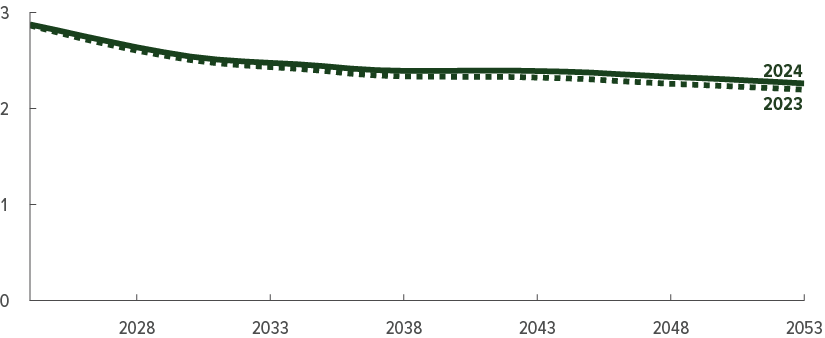
Primarily because of upward revisions to projected net immigration, the ratio of people ages 25 to 64 to those age 65 or older is larger in CBO’s current projections than it was in last year’s projections.
Changes to Projected Fertility Rates
In CBO’s current projections, the total fertility rate reaches 1.70 by 2034. That long-run total fertility rate is lower than the 1.75 births per woman that the agency projected last year and closer to the rate observed in 2022 (the most recent year for which data are available).2 As a result of that change, the total fertility rate from 2024 to 2053 is lower, on average, than the agency projected last year. However, because the population is now larger in most years of the 30-year period than CBO projected last year, the number of births is higher than CBO projected last year in most years—by about 70,000 per year from 2024 to 2034, on average.3 However, by 2048, the number of births is slightly lower than CBO projected last year.
Fertility Rates in CBO’s 2023 and 2024 Projections
Births per woman
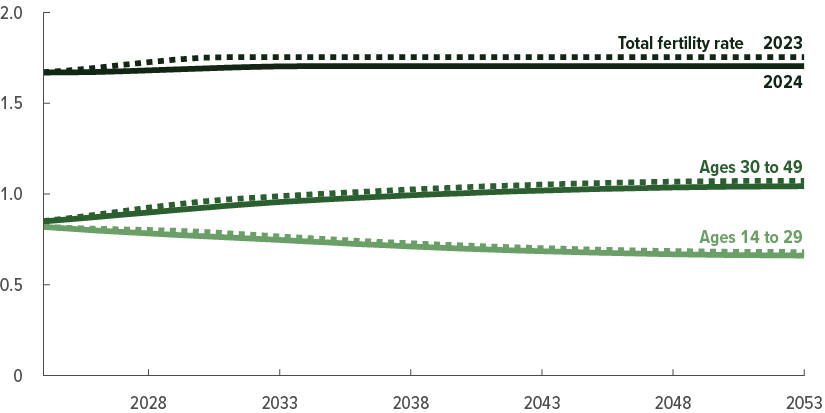
Consistent with CBO’s projections last year, this year’s projections reflect increasing rates of fertility for older mothers and decreasing rates of fertility for younger mothers over the next 30 years. Fertility rates for women of all ages are slightly lower than CBO projected last year.
Changes to Projected Mortality Rates
CBO reduced the projected number of deaths attributable to COVID-19. That reduction is based on the latest data available from the Centers for Disease Control and Prevention and an assessment of future trends in mortality due to COVID-19. CBO currently projects 10,000 (or 0.4 percent) fewer deaths per year, on average, from 2024 to 2033 than it did last year. After 2033, mortality rates generally return to previously projected levels, but, beginning in 2036, those rates are slightly higher than CBO projected last year because some of the deaths that previously occurred in the near term are now projected to occur in later years. Largely because the population is bigger in this year’s projections than it was in last year’s, the number of deaths is now projected to be larger by 100,000 (or 2.6 percent) per year, on average, from 2034 to 2053.
Life expectancies at birth and at age 65 are projected to average 79.3 years and 20.0 years, respectively, from 2024 to 2033. Those projections are slightly higher than the agency’s estimates last year (79.0 years and 19.7 years). For the third decade of the period (2044 to 2053), average life expectancies at birth and at age 65 are 81.6 years and 21.4 years in CBO’s projections—slightly lower than those estimated last year (81.8 years and 21.5 years, respectively).
Mortality Rates in CBO’s 2023 and 2024 Projections, Adjusted for Age and Sex
Deaths per 100,000 people
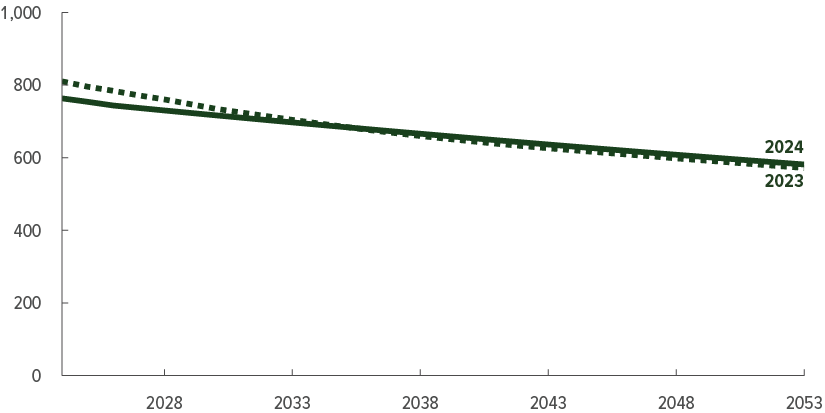
Through 2035, the mortality rate is lower in CBO’s current projections than in last year’s because the agency reduced its projections of deaths attributable to COVID-19. Starting in 2036, the mortality rate is projected to be higher in this year’s estimates than in last year’s.
Changes to Projected Net Immigration
In CBO’s current estimates, net immigration is larger than the agency estimated last year, by 0.7 million people in 2021, 1.4 million people in 2022, 1.9 million people in 2023, 2.1 million people in 2024, 1.5 million people in 2025, and 0.7 million people in 2026. Those differences occur primarily because net immigration of people in the other-foreign-national category is projected to be larger than the agency projected last year. In CBO’s assessment, two factors largely account for those increases in its estimates:
- Customs and Border Protection officials are encountering more people attempting to enter the United States and are releasing more of them into the country with humanitarian parole or with a notice to appear before an immigration judge, and
- More people are illegally entering the country without encountering Customs and Border Protection officials.
Data from the Department of Homeland Security indicate that increases in immigration of people in the other-foreign-national category have occurred in recent years as a result of those factors. In addition, data from the Current Population Survey show increases in the foreign-born share of the population in 2022 and 2023 that are broadly consistent with the increases in net immigration of other foreign nationals, although those data do not provide information about the legal status of people.
Net Immigration in CBO’s 2023 and 2024 Projections
Millions of people
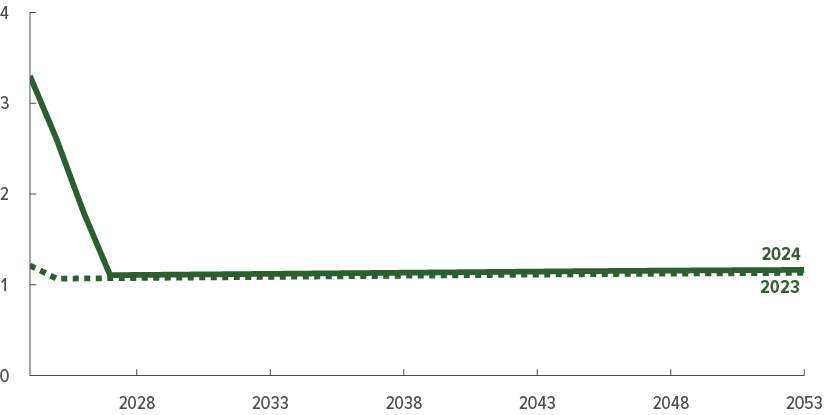
A projected increase of 5.0 million people, on net, in the other-foreign-national category from 2024 through 2026 is the primary factor boosting net immigration above last year’s projection in the near term. In CBO’s assessment, by 2027, net immigration of other foreign nationals returns to a number that is closer to historical levels, and net immigration is slightly larger than the agency previously projected.
Changes Since Last Year in the Population Projections CBO Uses to Estimate the Size of the Labor Force
In CBO’s current projections, the civilian noninstitutionalized population (the measure CBO uses to estimate the size of the labor force) is 2.6 percent larger (equaling 7.9 million more people) in 2053 than the agency projected last year.
From 2024 to 2053, CBO’s projection of the civilian noninstitutionalized population ages 25 to 54 is larger by 4.8 million people (or 3.6 percent) per year, and the population ages 16 to 24 is larger by 1.5 million people (or 4.0 percent) per year, on average, than in the agency’s projections last year. The differences stem from upward revisions to CBO’s projections of net immigration and near-term reductions to mortality rates, which are partially offset by reductions to projected fertility rates. Those rates of immigration, fertility, and mortality underlie CBO’s projection of the Social Security area population, which is used to construct the agency’s projection of the civilian noninstitutionalized population.
The agency’s projections of the civilian noninstitutionalized population ages 55 to 64 and age 65 or older are slightly higher than last year, by an average of 740,000 people (or 1.8 percent) and 270,000 people (or 0.4 percent) per year, respectively. Those differences mainly result from lower projected rates of mortality attributable to COVID-19 and changes to the agency’s projections of net immigration.
Civilian Noninstitutionalized Population in CBO’s 2023 and 2024 Projections, by Age Group
Millions of people
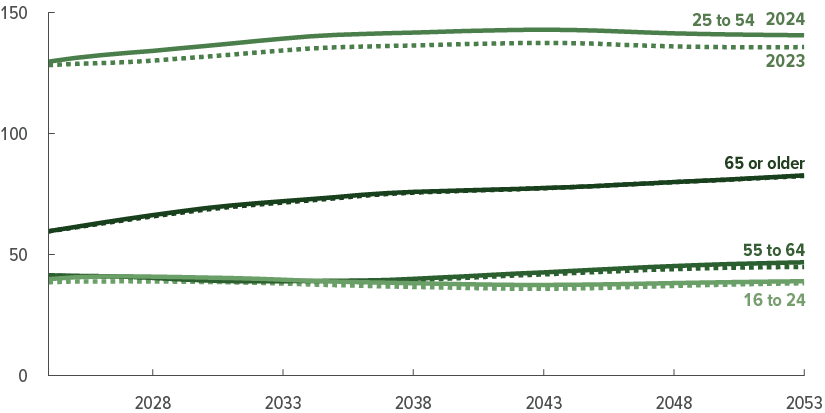
In this year’s projections, the largest change from last year’s is an increase in the number of people ages 25 to 54, who are likely to be in the labor force. Those revisions stem mostly from increased net immigration.
1. Michelle J. K. Osterman and others, “Births: Final Data for 2020,” National Vital Statistics Reports, vol. 70, no. 17 (National Center for Health Statistics, February 2022), https://tinyurl.com/muju38jy (PDF).
2. Brady E. Hamilton, Joyce A. Martin, and Michelle J. K. Osterman, “Births: Provisional Data for 2022,” Vital Statistics Rapid Release, no. 28 (National Center for Health Statistics, June 2023), www.cdc.gov/nchs/data/vsrr/vsrr028.pdf.
3. CBO does not project fertility rates by place of birth. A larger population driven primarily by increased net immigration results in a greater number of births, but that larger number of births is not a result of different fertility rates for foreign-born women.
Appendix AComparing CBO’s Population Projections With Those of Other Agencies
In addition to the Congressional Budget Office, other agencies, such as the Census Bureau and the Social Security Administration (SSA), produce projections of the population. This appendix compares CBO’s latest population projections with the latest projections released by the Census Bureau, in November 2023, and by SSA, in March 2023.1
SSA produces population projections that underlie its projections of the finances of the Social Security trust funds. SSA’s population projections include an intermediate alternative, which represents its trustees’ best estimates of future outcomes. SSA also produces projections that reflect different assumptions about future rates of fertility, mortality, and net immigration. For ease of presentation, this appendix examines only the intermediate alternative.
The Census Bureau produces a central projection of the resident population, known as its main series, as well as projections under scenarios in which net immigration is greater or less than in the main series. In the scenario with greater net immigration, total immigration exceeds that in the main series by 50 percent. In the scenario with less net immigration, total immigration is projected to be less than in the main series by a similar amount.
CBO’s 2024 population projections are most similar to the Census Bureau’s projections under the high immigration scenario. CBO’s projected population is larger in the near term than both the Census Bureau’s main series and SSA’s projected population. By the end of the 30-year projection period, CBO’s projected population is smaller than that in the Census Bureau’s high immigration scenario and SSA’s projection but larger than the Census Bureau’s main series (see Figure A-1).
Figure A-1.
CBO’s and Other Agencies’ Projections of the Population
Millions of people

Largely because of greater estimated net immigration, CBO’s projection of the population is higher in the near term than SSA’s and the Census Bureau’s projections. In later years, CBO’s population projection is lower than SSA’s projection and the Census Bureau’s high immigration scenario.
Data source: Congressional Budget Office. See www.cbo.gov/publication/59697#data.
SSA = Social Security Administration, Office of the Chief Actuary.
CBO’s and SSA’s projections represent the Social Security area population. The Census Bureau’s projection represents the resident area population.
Comparing CBO’s Projections of Fertility Rates With Those of Other Agencies
CBO’s projection of the total fertility rate is slightly higher than the Census Bureau’s projection and lower than SSA’s projection. In CBO’s projections, the total fertility rate rises from 1.67 births per woman in 2024 to 1.70 births per woman by 2034 and remains at that level thereafter. By comparison, the Census Bureau projects that the total fertility rate will be 1.63 in 2024 and then will gradually fall to 1.62 by 2034 and to 1.60 by 2054. SSA projects that the total fertility rate will rise from 1.72 in 2024 to 1.91 in 2034 and to 2.00 by 2054 (see Figure A-2).
Figure A-2.
CBO’s and Other Agencies’ Projections of Fertility Rates
Births per woman
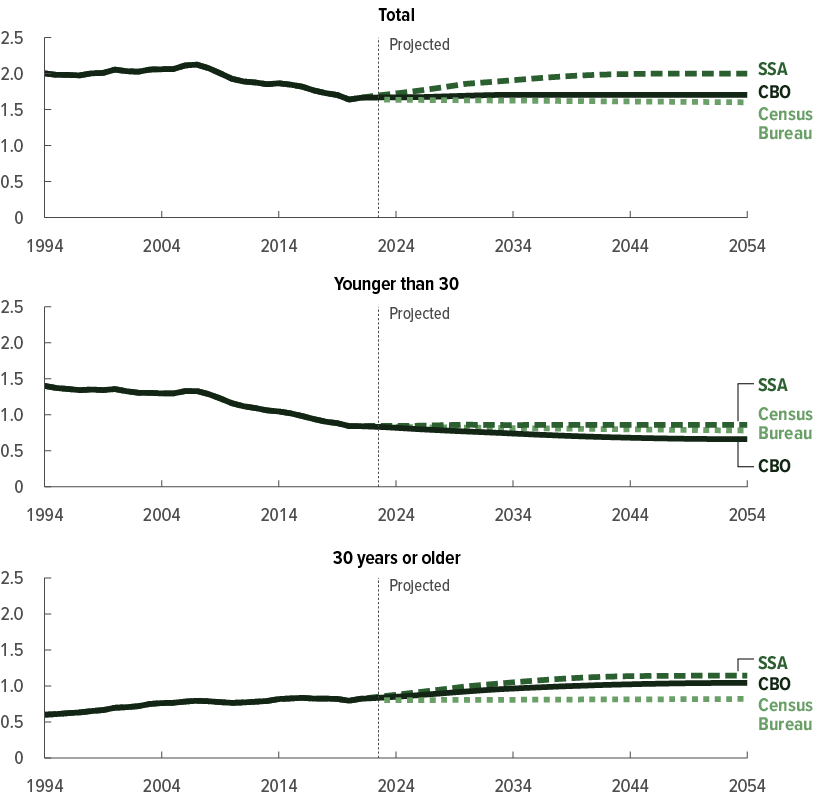
CBO projects a lower total fertility rate than SSA does because, in CBO’s projections, fertility rates for women ages 14 to 29 decline more and fertility rates for women ages 30 to 49 rise less than in SSA’s projections. Both CBO and SSA project a higher total fertility rate than the Census Bureau does.
Data source: Congressional Budget Office. See www.cbo.gov/publication/59697#data.
SSA = Social Security Administration, Office of the Chief Actuary.
The total fertility rate represents the average number of children that a woman would have if, in each year of her life, she experienced the birth rates observed or assumed for that year and if she survived her entire childbearing period, which CBO and SSA estimate is from ages 14 through 49 and the Census Bureau estimates is from ages 14 through 54.
CBO’s projection of the total fertility rate differs from other agencies’ projections, in part because of differences in projected trends in childbearing by age. In CBO’s projections, the total fertility rate rises because rates for women ages 30 to 49 rise, reflecting delayed childbearing by women who had fewer or no children at younger ages. That trend is also reflected in SSA’s projections. However, CBO projects a lower total fertility rate than SSA does because CBO projects that rates for women of younger ages will continue their downward trend, whereas SSA projects smaller changes in the rates for women of younger ages. Additionally, CBO projects a smaller increase than SSA does in fertility rates for women ages 30 to 49.
Both CBO and SSA project higher fertility rates than the Census Bureau does. Much of that difference occurs because the Census Bureau projects lower fertility rates than CBO and SSA do for women age 30 or older. Although the Census Bureau projects a slightly rising trend in fertility rates for women age 30 or older, the changes are generally smaller than those projected by CBO and SSA. CBO, the Census Bureau, and SSA all project a decline in fertility rates for women ages 14 to 29, though the decline in SSA’s projection is relatively small.
Comparing CBO’s Projections of Mortality Rates With Those of Other Agencies
CBO projects mortality rates on the basis of historical trends and then incorporates the effects of the coronavirus pandemic. Because CBO projects that mortality rates will decline from 2024 to 2054, the agency’s projection of life expectancy at birth rises, from 78.7 years to 82.2 years (see Figure A-3).2 Those projections of life expectancy are slightly lower in 2024 and slightly higher in 2054 than SSA’s projections (78.9 years in 2024 and 81.9 years in 2054). CBO’s and SSA’s projections of life expectancy at birth are both lower than the Census Bureau’s projections (79.9 years in 2024 and 83.7 years in 2054).
Figure A-3.
CBO’s and Other Agencies’ Projections of Life Expectancy at Birth
Years
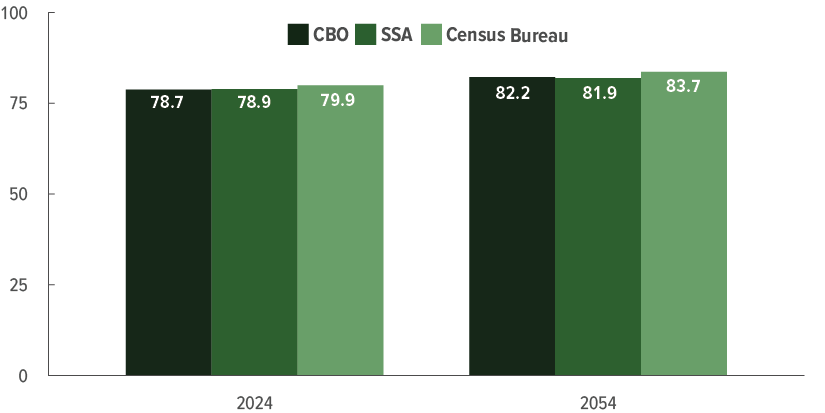
CBO’s projections of life expectancy at birth are similar to SSA’s projections. Both CBO and SSA project lower life expectancy at birth than the Census Bureau does.
Data source: Congressional Budget Office. See www.cbo.gov/publication/59697#data.
SSA = Social Security Administration, Office of the Chief Actuary.
Comparing CBO’s Projections of Net Immigration With Those of Other Agencies
CBO’s projections of net immigration are based on recent information from the Department of Homeland Security (DHS) and the Census Bureau. Data from DHS indicate that the number of people in the other-foreign-national category entering the country has increased significantly during the past three years, and data from the Census Bureau show an increase in the share of the foreign-born population. Both of those sources inform CBO’s projections of net immigration. (For more details on CBO’s projection of net immigration, see Appendix B.)
CBO’s projections of net immigration are higher in the near term than SSA’s projections (see Figure A-4). For 2023 and 2024, SSA projects an increase in net immigration, reflecting an expectation that some people who planned to immigrate in 2020 or 2021 would delay their immigration until 2023 or 2024 because of disruptions resulting from the coronavirus pandemic.3 CBO’s projections are greater than SSA’s by 1.3 million people in both 2023 and 2024. After 2025, CBO’s projection of net immigration is less than SSA’s by about 140,000 people per year, on average.
Figure A-4.
CBO’s and Other Agencies’ Projections of Net Immigration
Millions of people
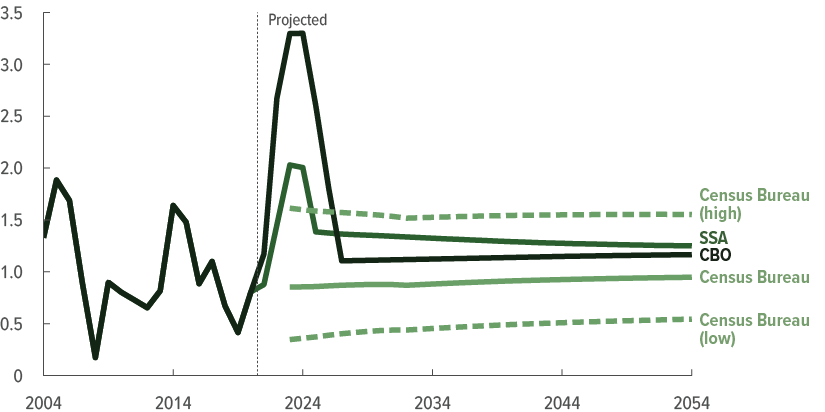
In the near term, CBO’s projection of net immigration is higher than SSA’s and the Census Bureau’s projections. In later years, CBO’s projection of net immigration is lower than SSA’s but higher than the Census Bureau’s projections in its main series.
Data source: Congressional Budget Office. See www.cbo.gov/publication/59697#data.
SSA = Social Security Administration, Office of the Chief Actuary.
CBO’s projections are also greater than the Census Bureau’s projections in its main series and its scenario with lower net immigration. CBO’s projections are greater than the Census Bureau’s scenario with higher net immigration by 1.7 million people in 2023 and 2024 and by 1.0 million people in 2025. After 2025, CBO’s projections are lower than the Census Bureau’s high immigration scenario.
1. For more information about the Social Security Administration’s projections, see Social Security Administration, Office of the Chief Actuary, The 2023 Annual Report of the Board of Trustees of the Federal Old-Age and Survivors Insurance and Federal Disability Insurance Trust Funds (March 2023), www.ssa.gov/OACT/TR/2023. For more information about the Census Bureau’s projections, see Census Bureau, Methodology, Assumptions, and Inputs for the 2023 National Population Projections (November 2023), https://tinyurl.com/5n7wemnz (PDF).
2. CBO’s projections of mortality rates used historical data from 2020, the latest year available at the time. CBO’s projection of life expectancy at birth in 2022 is consistent with the Centers for Disease Control and Prevention’s provisional estimate of life expectancy in that year (77.58 years and 77.5 years, respectively). For more details, see Elizabeth Arias and others, “Provisional Life Expectancy Estimates for 2022,” Vital Statistics Rapid Release, no. 31 (National Center for Health Statistics, November 2023), www.cdc.gov/nchs/data/vsrr/vsrr031.pdf.
3. For more details, see Social Security Administration, Office of the Chief Actuary, “Immigration,” in The Long-Range Demographic Assumptions for the 2023 Trustees Report (March 2023), p. 3, https://tinyurl.com/6jzku8wc.
Appendix BHow CBO Projects Net Immigration of People in the Other-Foreign-National Category
In developing its 2024 population projections, the Congressional Budget Office revised its projection of net immigration of people in the other-foreign-national category. That category includes the following groups of people:
- Those who entered the United States illegally and have not obtained a permanent legal status;
- Those who were permitted to enter the country lawfully through the use of parole authority and who may be awaiting proceedings in immigration court; and
- Those who previously resided in the United States legally in a temporary status but who remained in the country after that legal status expired.1
Therefore, in this report, net immigration of people in the other-foreign-national category encompasses people who enter that category after arriving from foreign countries as well as people who previously resided in the United States in a temporary status.2 It is reduced to account for people who are no longer in the other-foreign-national category, either because they emigrated or because they obtained a legal immigration status.3
CBO estimates that net immigration in the other-foreign-national category was 2.4 million in 2023. By comparison, that number was 600,000 in 2021 and 1.9 million in 2022, CBO estimates. In 2024, as in 2023, CBO projects that 2.4 million people, on net, will immigrate in that category, after which that number will transition to a rate that is closer to historical levels, declining to 200,000 people in 2027, remaining at that level through 2044, and then growing at the same rate as the overall population through 2054.
CBO increased the number of people in the other-foreign-national category in this year’s projections in response to recent data and information from the Department of Homeland Security (DHS) and the Census Bureau. Publicly available data from DHS show that Customs and Border Protection (CBP) officials—officers in the Border Patrol working between ports of entry and officers in the Office of Field Operations (OFO) working at ports of entry—are encountering more people attempting to enter the country than in previous years, including years before the coronavirus pandemic.4 More of those people are also being released into the United States than previously, generally through the use of parole authority or with a notice to appear before an immigration judge. In addition, consistent with the information from DHS, data from the Census Bureau show increases in the share of foreign-born people in the United States.
Projections of the net immigration of people in the other-foreign-national category are especially uncertain. For example, information about people in that category who leave the United States is scarce. CBO will continue to evaluate new data as they become available.
CBO’s Estimates of Net Immigration of People in the Other-Foreign-National Category in 2023
The two data sources CBO used yield slightly different estimates of net immigration in the other-foreign-national category. Using DHS data, CBO estimates that such immigration was 2.5 million in 2023; using data from the Census Bureau, CBO estimates that the number was 2.2 million. From those two analyses combined, CBO estimates that 3.3 million people, on net, immigrated to the United States in 2023, and net immigration in the other-foreign-national category was 2.4 million.
Those estimates represent significant increases over the agency’s estimates for 2021 and 2022. Using those same data and methods, CBO estimates that, on net, the number of people immigrating to the United States was 1.2 million in 2021 and 2.7 million in 2022; net immigration in the other-foreign-national category was 600,000 in 2021 and 1.9 million in 2022.
Estimates Using Data From the Department of Homeland Security
To calculate net immigration of people in the other-foreign-national category using DHS’s data, CBO first estimated the total number of such people who entered the United States or overstayed their temporary status—3.3 million in fiscal year 2023. CBO then subtracted from that total the estimated number of other foreign nationals who emigrated or who obtained a permanent legal immigration status—a total of 660,000 people.5 Thus, using data from DHS, CBO estimates that net immigration of people in the other-foreign-national category was 2.6 million in fiscal year 2023, or 2.5 million people in calendar year 2023.
Estimates of People Entering the Other-Foreign-National Category. To determine that 3.3 million number, CBO combined information about four groups: people who entered the country between official points of entry and were released into the country by CBP officials (1.1 million), people who entered the country at official points of entry and were released into the country by CBP officials (900,000), people who entered without encountering a CBP official (860,000), and people who entered legally in a temporary status but overstayed their term of residency (430,000).
People Arriving Between Official Ports of Entry. In fiscal year 2023, a total of 1.1 million people were released into the country after encountering a CBP official between official ports of entry, CBO estimates. Nearly all of those people were encountered and released at the southwest border.
DHS reports that, in fiscal year 2023, 1.1 million people who arrived at the southwest border were released into the country by the Border Patrol with a Notice to Appear (NTA) or with parole or were detained with a warrant of arrest. Those detained included unaccompanied children who were temporarily placed in the custody of the Office of Refugee Resettlement, as well as people who were given an NTA and transferred to the custody of Immigration and Customs Enforcement, from which they were frequently released.6
Many fewer people were released after being encountered between official ports of entry in other parts of the country in fiscal year 2023. Fewer than 10,000 people were released at the northern border or near the coasts of the United States, in CBO’s assessment. CBO developed that estimate from information about the number of encounters nationwide, encounters at the southwest border, and the rate that people encountered at the southwest border were released into the country.7
People Arriving at Official Ports of Entry. CBO estimates that the Office of Field Operations released about 900,000 people from official ports of entry in fiscal year 2023. CBP’s data show that OFO released 580,000 people through July 2023. That number includes 280,000 people released with an NTA and 300,000 people released with parole.8 On the basis of historical rates of release and DHS’s information about the CBP One parole program and the Cuban, Haitian, Nicaraguan, and Venezuelan (CHNV) parole program, CBO estimates that OFO released people at a faster rate in the remaining two months of the fiscal year—releasing an additional 290,000 people with an NTA or parole.9
People Not Encountering a CBP Official. CBO estimates that an additional 860,000 people in the other-foreign-national category crossed a U.S. border without encountering a CBP official in fiscal year 2023. That total comprises people who were directly or indirectly observed making an unlawful entry, who were not turned back or apprehended, and who are no longer being pursued by the Border Patrol (sometimes referred to as “got-aways”), as well as estimates of the number of people who crossed the border without being observed or detected.10 Although DHS publishes estimated counts of people in the first group, it had not released its official estimates for fiscal year 2023 at the time CBO made its projection, in November 2023. Instead, CBO’s estimate is based partly on testimony by the Secretary of DHS, who said that more than 600,000 such people entered the United States in 2023.11 Additionally, according to media reports, Border Patrol officials indicated that the number was 770,000 people in 2023.12 Using those numbers, CBO estimated that there were 750,000 people in the first group in fiscal year 2023.
To account for the second group, people who crossed the border but were not observed or detected by CBP officials, CBO then adjusted the estimate of 750,000 people upward by 15 percent (or 110,000 people), to 860,000 people, following testimony by the Chief of the Border Patrol, who said that the estimated number probably undercounted those people by 10 percent to 20 percent.13
People Overstaying Their Temporary Status. CBO estimates that 430,000 people who previously resided in the country legally in a temporary status remained after that legal status expired in fiscal year 2023. CBO developed that estimate from DHS’s data, which indicated that nearly 800,000 people may have overstayed (known as “suspected in-country overstays” in the data) in fiscal year 2022.14 By CBO’s estimate, the number of people who overstayed in 2023 was about the same as in 2022, and CBO adjusted the estimate from DHS downward because some of those people may have overstayed for only a short time.
That adjustment is based on information about the number of people who entered legally in a temporary status but stayed beyond the period for which they had that legal status in prior years. Specifically, DHS reports that 46 percent of people who were estimated to have overstayed their visa at the end of fiscal year 2016 and remained in the country were no longer in that category by May 2018 because they had either left the country or obtained a permanent legal status in the intervening period.15 In other words, DHS estimates that 54 percent of people who had overstayed their visa at the end of 2016 were still overstaying their visa 20 months later, in May 2018. Using that information, as well as similar declines observed in the number of people who may have initially overstayed in 2015 or in 2017 through 2020 and remained in later periods, CBO estimates that about 430,000 people who had entered legally in previous years but overstayed their temporary status were present in the United States in fiscal year 2023.
Estimates of People Leaving the Other-Foreign-National Category. In CBO’s assessment, a total of about 660,000 people in the other-foreign-national category either emigrated from the population or obtained a permanent legal status in fiscal year 2023. Of those, about 440,000 people emigrated in fiscal year 2023, CBO estimates. The agency developed that estimate using two rates of emigration: one for people who resided in the country in 2022 and emigrated in 2023, and one for people who arrived in 2023 but did not remain the entire year. CBO estimates that 2.5 percent of the estimated 13.6 million other foreign nationals present in 2022—about 340,000 people—emigrated in fiscal year 2023.16 Additionally, in CBO’s assessment, 100,000 people, or 3.2 percent, of the 3.1 million other foreign nationals who arrived in fiscal year 2023 (and did not obtain a permanent legal status) emigrated before the end of that fiscal year.17
CBO estimates that about 225,000 other foreign nationals obtained a permanent legal status in fiscal year 2023. That group included people who were (or would become) immediate relatives of U.S. citizens, those who were not immediate relatives of U.S. citizens but were eligible for a permanent legal status under a family preference, those who were granted asylum, and those who qualified under the Cuban Adjustment Act, as amended.18
Estimates Using Data From the Current Population Survey
Using data from the Census Bureau’s Current Population Survey (CPS), CBO estimates that net immigration of people in the other-foreign-national category was 2.2 million people in 2023. CBO based that assessment on its estimates of the share of the population that was foreign-born in 2022 and 2023, which were developed from CPS data; its estimates of fertility and mortality in 2022 and 2023; and its estimate of the share of total net immigration that was attributable to net immigration by other foreign nationals.
To estimate the change in the number of other foreign nationals in the United States between 2022 and 2023 using CPS data, CBO first estimated that 15.6 percent of the population was foreign-born in 2022 and 16.2 percent of the population was foreign-born in 2023. CBO produced those estimates in two steps:
- In the first step, the agency used publicly available monthly data from the CPS to estimate that the share of the population that was foreign-born increased from 15.2 percent in 2022 to 15.7 percent in 2023.19 Those estimates incorporate adjustments that the Census Bureau makes in publicly available survey data to account for people who receive the survey but do not respond to it.
- In the second step, CBO incorporated an additional adjustment to the undercount rate for the foreign-born population because the Census Bureau’s adjustments do not take into account country of birth, and, in CBO’s assessment, undercounting is likely to be greater for foreign-born people than for native-born people.20 In particular, the agency estimated that foreign-born people were undercounted by an additional amount (beyond that accounted for by the Census Bureau’s adjustments) equal to one-half of the nonresponse rate for the CPS.21 For example, in 2022, the share of the foreign-born population estimated from the publicly available survey data was 15.2 percent, and the nonresponse rate for the survey was 27 percent. CBO adjusted the number of people in the survey who were foreign-born upward by 13.5 percent (half of 27 percent) and then recalculated the share of the population that was foreign-born. After applying that adjustment for 2022, CBO estimated that the share of the foreign-born population in 2022 was 15.6 percent. Applying that same strategy to data from 2023, CBO estimated that 16.2 percent of the population was foreign-born in 2023.
Next, CBO estimated total net immigration between 2022 and 2023 by estimating the total change in the number of people who were foreign-born from the population shares estimated in the first step and the agency’s own projections of the size of the native-born population in those years. The estimates of the size of the native-born population are derived from the Social Security Administration’s estimate of that population at the beginning of 2021 and CBO’s projections of fertility and mortality. CBO then accounted for the share of that change that was attributable to deaths of foreign-born people who were residing in the country in 2022. Using that approach, CBO estimated that the foreign-born population grew from 52.5 million people in 2022 to 55.1 million people in 2023 and that there were about 530,000 deaths among the foreign-born population. Thus, total net immigration—in all categories—was about 3.1 million people in 2023.
Finally, CBO used CPS data to estimate how many of those 3.1 million people were in the other-foreign-national category by subtracting the agency’s projection of two other categories of immigration in 2023: lawful permanent residents and people who were eligible to apply for lawful permanent residence on the basis of their current status, and people who were admitted as nonimmigrants under the Immigration and Nationality Act. CBO separately estimated that net immigration of people in those two categories was 900,000 people in 2023, and thus CBO’s estimate of net immigration of other foreign nationals using CPS data is 2.2 million people in 2023.
CBO’s Projections of Net Immigration of People in the Other-Foreign-National Category Beyond 2023
In CBO’s projections, net immigration of people in the other-foreign-national category remains at its 2023 level through 2024, then transitions to a rate that is closer to historical levels (200,000 people per year) by 2027, and remains at that level through the end of the second decade (2035 to 2044) of CBO’s 30-year projection period. The decline in net immigration between 2024 and 2026 may stem from changes in decisions by other foreign nationals to enter or leave the United States, changes in actions by the Administration or immigration judges, or a combination of those changes. In the third decade (2045 to 2054) of the projection period, net immigration of other foreign nationals is expected to grow at the same rate as the domestic population.
1. People paroled into the United States under 8 U.S.C. § 1182(d)(5) are permitted to be in the country temporarily “for urgent humanitarian reasons or significant public benefit.” They are considered to have entered lawfully and to be in the country lawfully during their period of parole.
2. For a complete definition of the other-foreign-national category and other categories of immigrants used in this report, see Appendix C. The other categories are LPR+ (lawful permanent residents plus people who are eligible to apply to become LPRs on the basis of their current status) and INA nonimmigrants (people who are defined as nonimmigrants under the Immigration and Nationality Act).
3. Reductions in the population in that category because of deaths are accounted for in CBO’s mortality projections.
4. The Office of Field Operations is responsible for border security and for facilitating the lawful trade and travel at U.S. ports of entry. The Border Patrol enforces immigration laws and detects, interdicts, and apprehends those who attempt to illegally enter or smuggle people or contraband across U.S. borders between official Customs and Border Protection ports of entry. The Border Patrol is also responsible for preventing terrorists and terrorist weapons from entering the United States between official ports of entry.
5. Analyses for other previous years follow a similar process. CBO first converted fiscal year totals to represent calendar years where applicable.
6. See Customs and Border Protection, “USBP Monthly Southwest Border Encounters by Processing Disposition” (December 19, 2023), www.cbp.gov/newsroom/stats/custody-and-transfer-statistics-fy2023.
7. CBO developed that estimate by multiplying the number of nationwide encounters minus the number of encounters at the southwest border by one-half of the release rate from the southwest border (southwest border releases divided by southwest border encounters). That is, CBO estimates that the release rate of people encountered between official ports of entry that are not at the southwest border is half that of the release rate at the southwest border.
8. See the OFO disposition categories “Paroled” and “Notice to Appear” at TRAC Immigration, “Stopping ‘Inadmissibles’ at U.S. Ports of Entry” (Transactional Records Access Clearinghouse, 2023), https://trac.syr.edu/phptools/immigration/cbpinadmiss.
9. For information about the CBP One parole program, see Customs and Border Protection, “CBP One Mobile Application” (December 15, 2023), www.cbp.gov/about/mobile-apps-directory/cbpone. For information about the CHNV parole program, see Citizenship and Immigration Services, “Processes for Cubans, Haitians, Nicaraguans, and Venezuelans” (September 20, 2023), www.uscis.gov/CHNV.
10. For the definition of “got away,” see 6 U.S.C. § 223(a)(3), http://tinyurl.com/5n7uv2um.
11. See Department of Homeland Security, Department of Homeland Security Border Security Metrics Report: 2022 (July 2023), http://tinyurl.com/yxj683a9 (PDF), and Testimony of Alejandro N. Mayorkas, Secretary, Department of Homeland Security, before the Senate Committee on Homeland Security and Governmental Affairs, Threats to the Homeland (October 31, 2023), http://tinyurl.com/3ndcrvpd, time stamp 1:51:34.
12. See Bethany Blankley, “Nearly 4 Million Illegal Border Crossers in Fiscal 2023,” Center Square (October 26, 2023), http://tinyurl.com/4bytvmcu.
13. See Testimony of Raul L. Ortiz, Chief, Border Patrol, before the House Committee on Homeland Security, Failure by Design: Examining Secretary Mayorkas’ Border Crisis (March 15, 2023), http://tinyurl.com/3tbv2w65, time stamp 1:08:15.
14. The most recent data available at the time of CBO’s analysis were for fiscal year 2022. See Customs and Border Protection, Fiscal Year 2022 Entry/Exit Overstay Report (June 2023), Table 1, http://tinyurl.com/3pv5cjw4 (PDF).
15. Department of Homeland Security, Fiscal Year 2017 Entry/Exit Overstay Report, Table 9, http://tinyurl.com/ymd2hz9r (PDF).
16. Research suggests that the emigration rate for unauthorized residents who have lived in the country for 10 years is 2.0 percent; CBO adjusted that estimate to account for the fact that other foreign nationals living in the country in 2022 arrived at different times. See Robert Warren and John Robert Warren, “Unauthorized Immigration to the United States: Annual Estimates and Components of Change, by State, 1990 to 2010,” International Migration Review, vol. 47, no. 2 (June 2013), pp. 296–329, https://doi.org/10.1111/imre.12022.
17. Robert Warren and John Robert Warren, “Unauthorized Immigration to the United States: Annual Estimates and Components of Change, by State, 1990 to 2010,” International Migration Review, vol. 47, no. 2 (June 2013), pp. 296–329, https://doi.org/10.1111/imre.12022.
18. See Cuban Adjustment Act, P.L. 89-732, 80 Stat. 1161 (1966) (codified as amended at 8 U.S.C. § 1255 note), http://tinyurl.com/2uzhfpth (PDF).
19. At the time of this analysis, monthly CPS data was available through October 2023. CBO estimated the foreign-born share of the population in November and December 2023 by extrapolating trends through the end of the calendar year.
20. The CPS estimation procedure weights the data from each person in the sample to adjust for people who were unable or unwilling to respond to the survey and to apply a ratio estimation procedure, which reweights the distribution of the population selected for the sample to match the population as a whole for characteristics such as age, sex, race, and state of residence. See Census Bureau, “Weighting” (January 12, 2022), http://tinyurl.com/4uncftpu.
21. Response rates for the CPS have declined in recent years, from about 90 percent in early 2014 to 70 percent in July 2023. See Bureau of Labor Statistics, Office of Survey Methods Research, “Household Survey Response Rates” (August 30, 2023), http://tinyurl.com/yev5hs9u.
Appendix CTerms Used in This Report
In this report, population refers to the Social Security area population, which includes all residents of the 50 U.S. states and the District of Columbia, as well as civilian residents of U.S. territories. It also includes federal civilian employees and members of the U.S. armed forces living abroad and their dependents, U.S. citizens living abroad, and noncitizens living abroad who are eligible for Social Security benefits on the basis of their earnings while in the United States.
The Congressional Budget Office projects the Social Security area population on January 1 of a given year by starting with the population on January 1 of the previous year, adding the projected number of people who are born into that population or who immigrate (and thus become part of that population), and subtracting the projected number who die or who emigrate (and thus are no longer part of that population) during that year.
CBO groups the Social Security area population into four main categories.
- The U.S. national category comprises U.S citizens and people who were born or whose parents were born in American Samoa or on Swains Island on or after the date the United States acquired the possessions; the latter are U.S. nationals but not U.S. citizens by birth.
- LPR+ is a category that consists of lawful permanent residents (LPRs) plus people who are eligible to apply to become LPRs on the basis of their current immigration status. LPRs include those who are granted that status while within the United States as well as people who have gained admission from abroad. People can become eligible for LPR status by becoming an immediate relative of a U.S. citizen, through family-sponsored preferences, employment-based preferences, or diversity visas (from countries with low rates of immigration into the United States) or by meeting certain other requirements. People who are eligible (or soon will become eligible) to apply to become LPRs include certain immediate relatives of a U.S. citizen—such as a fiancé or fiancée—and those granted refugee status, asylum, or another status that may allow them to adjust their status to that of a lawful permanent resident (for example, victims of human trafficking and certain parolees).1
- The INA nonimmigrant category comprises temporary workers, student exchange visitors, qualifying family members, and others admitted as nonimmigrants under the Immigration and Nationality Act (INA)—for example, officials of foreign governments—while they remain in that status.2
- The other-foreign-national category consists of people in the United States who are not in the U.S. national, LPR+, or INA nonimmigrant categories. The category includes people in the following groups who have not subsequently become U.S. citizens or received LPR, asylee, or nonimmigrant status: people who entered the United States illegally; people who entered legally in a temporary status and then remained after that legal status expired; and people who were permitted to enter despite not being admissible as an LPR, asylee, refugee, or nonimmigrant—which typically occurs through the use of parole authority and includes those who may be awaiting proceedings in immigration court. Under several laws (such as the one that authorizes Temporary Protected Status) or policies (such as deferred action), the government might choose not to seek the removal of people in this category for a specified or indefinite period. People in the other-foreign-national category might be eligible to apply for employment authorization through several channels (such as by receiving Temporary Protected Status or having applied for asylum). People paroled into the United States are considered to have entered lawfully and to be in the country lawfully during their period of parole.
This report also uses the following terms.
The civilian noninstitutionalized population includes people age 16 or older who are not members of the armed forces on active duty and who are not in penal or mental institutions or in homes for the elderly or infirm.
The total fertility rate represents the average number of children that a woman would have if, in each year of her life, she experienced the birth rates observed or assumed for that year and if she survived her entire childbearing period (which CBO and SSA estimate is from ages 14 to 49 and the Census Bureau estimates is from ages 14 to 54).
Life expectancy in a given year is the amount of time that a person would expect to survive on the basis of that year’s mortality rates for people of various ages, sometimes referred to as period life expectancy. (Cohort life expectancy, by contrast, incorporates projected changes in mortality rates and better reflects a person’s actual life expectancy.)
The mortality rate adjusted for age and sex represents the rate that would be observed if the projected mortality rates by age and sex occurred in a population that had the same age and sex composition as the population in a reference year. For its reference population, CBO uses the population in 2010—the same year that the Social Security Administration uses as the reference population in its 2023 Trustees Report.3
1. Department of Homeland Security, “Immigrant Classes of Admission” (November 20, 2023), https://tinyurl.com/dy2jn95c.
2. Sec. 101(a)(15) of the Immigration and Nationality Act, 8 U.S.C. § 1101(a)(15) (2024); and Department of Homeland Security, “Nonimmigrant Classes of Admission” (November 20, 2023), https://tinyurl.com/ms3yh9kv.
3. Social Security Administration, Office of the Chief Actuary, The 2023 Annual Report of the Board of Trustees of the Federal Old-Age and Survivors Insurance and Federal Disability Insurance Trust Funds (March 2023), www.ssa.gov/OACT/TR/2023.
About This Document
This volume is one of a series of reports on the state of the budget and the economy that the Congressional Budget Office issues each year. In keeping with CBO’s mandate to provide objective, impartial analysis, the report makes no recommendations.
Daniel Crown prepared the report with guidance from Molly Dahl and Julie Topoleski. Madeleine Fischer and Lucy Yuan fact-checked the report. Adam Abadi, Rebecca Heller, David Newman, Xiaotong Niu, Sam Papenfuss, David Rafferty, and Natalie Tawil contributed to the analysis in this report. Richard DeKaser, Ann E. Futrell, Tamara Hayford, John McClelland, Noah Meyerson, and Jaeger Nelson provided comments on an earlier draft.
Comments on CBO’s projections were provided by Andrew Arthur (Center for Immigration Studies), Steven Camarota (Center for Immigration Studies), Julia Gelatt (Migration Policy Institute), Joshua Goldstein (University of California, Berkeley), Ronald Lee (University of California, Berkeley), Ariel Ruiz Soto (Migration Policy Institute), Jennifer Van Hook (Pennsylvania State University), Robert Warren (Center for Migration Studies of New York), and staff from the Census Bureau and Department of Homeland Security. The assistance of external reviewers implies no responsibility for the final product; that responsibility rests solely with CBO.
Mark Doms, Jeffrey Kling, and Robert Sunshine reviewed the report. Rebecca Lanning edited it, and R. L. Rebach created the graphics, designed the cover, and prepared the text for publication. The report is available at www.cbo.gov/publication/59697.
CBO seeks feedback to make its work as useful as possible. Please send comments to communications@cbo.gov.

Phillip L. Swagel
Director
January 2024


